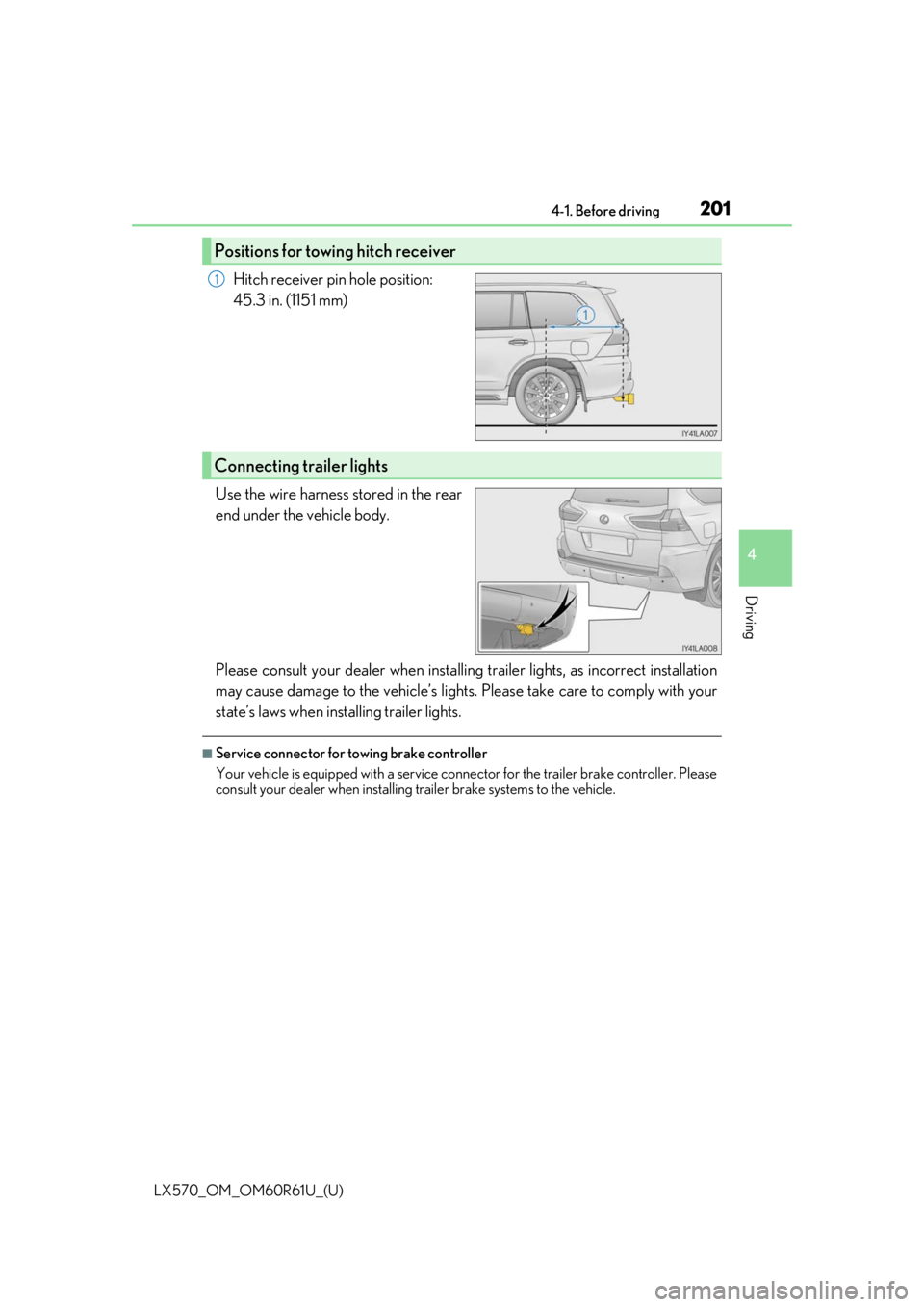tow LEXUS LX570 2020 Owner's Manual
[x] Cancel search | Manufacturer: LEXUS, Model Year: 2020, Model line: LX570, Model: LEXUS LX570 2020Pages: 636, PDF Size: 12.73 MB
Page 193 of 636

193
LX570_OM_OM60R61U_(U)4-1. Before driving
4
Driving
Trailer towing
Your vehicle is designed primarily as
a passenger-and-load-carrying vehicle.
Towing a trailer can have an adverse im pact on handling, performance, brak-
ing, durability, and fuel consumption. Fo r your safety and the safety of others,
you must not overload your vehicle or trailer. You must also ensure that you
are using appropriate towing equipment, that the towing equipment has been
installed correctly and used properly, and that you employ the requisite driv-
ing habits.
Vehicle-trailer stability and braking pe rformance are affected by trailer sta-
bility, brake performance and setting, tr ailer brakes, the hitch and hitch sys-
tems (if equipped).
To tow a trailer safely, use extreme ca re and drive the vehicle in accordance
with your trailer’s characteri stics and operating conditions.
Lexus warranties do not apply to damage or malfunction caused by towing a
trailer for commercial purposes.
Contact your Lexus dealer for further information about additional require-
ments such as towing kits, etc.
Page 194 of 636

194
LX570_OM_OM60R61U_(U)4-1. Before driving
■GCWR (Gross Combination Weight Rating)
The maximum allowable gross com-
bination weight. The gross combina-
tion weight is the sum of the total
vehicle weight (including the occu-
pants, cargo and any optional equip-
ment installed on the vehicle) and
the weight of the trailer being towed
(including the cargo in the trailer).
■GVWR (Gross Vehicle Weight Rating)
The maximum allowable gross vehi-
cle weight. The gross vehicle weight
is the total weight of the vehicle.
When towing a trailer, it is the sum of
the vehicle weight (including the
occupants, cargo and any optional
equipment installed on the vehicle)
and the tongue weight.
Towing related terms
Page 195 of 636

LX570_OM_OM60R61U_(U)
1954-1. Before driving
4
Driving
■GAWR (Gross Axle Weight Rating)
The maximum allowable gross axle
weight. The gross axle weight is the
load placed on each axle (front and
rear).
■TWR (Trailer Weight Rating)
The maximum allowable gross trailer
weight. The gross trailer weight is
the sum of the trailer weight and the
weight of the cargo in the trailer.
TWR is calculated assuming base
vehicle with one driver, one front
passenger, towing package (if avail-
able), hitch and hitch systems (if
required).
Additional optional equipment, passengers and cargo in the vehicle will reduce the
trailer weight rating so as not to exceed GCWR, GVWR and GAWR.
If the gross trailer weight exceeds 3000 lb. (1360 kg), it is recommended to use a
trailer with 2 or more axles.
Front GAWR
Rear GAWR
(With brakes)
Page 196 of 636

196
LX570_OM_OM60R61U_(U)4-1. Before driving
■Unbraked TWR (Unbraked Trailer Weight Rating)
The trailer weight rating for towing a
trailer without a trailer service brake
system.
■Tongue Weight
The load placed on the trailer hitch
ball. (
P. 198)
(Without brakes)
Page 197 of 636

LX570_OM_OM60R61U_(U)
1974-1. Before driving
4
Driving
●The gross trailer weight must never exceed 7000 lb. (3175 kg).
●The gross combination weight must never exceed 13400 lb. (6078 kg).
●The gross vehicle weight must never
exceed the GVWR indicated on the
Certification Label.
●The gross axle weight on each axle
must never exceed the GAWR indi-
cated on the Certification Label.
●If the gross trailer weight is over the unbraked TWR, trailer service brakes are
required.
●If the gross trailer weight is over 2000 lb. (907 kg), a sway control device with
sufficient capacity is required.
●If the gross trailer weight is over 5 000 lb. (2268 kg), a weight distributing
hitch with sufficient capacity is required.
Confirm that the gross trailer weight, gross combination weight, gross vehicle
weight, gross axle weight and tongue weight are all within the limits.
■GCWR*
13400 lb. (6078 kg)
■TWR*
7000 lb. (3175 kg)
■Unbraked TWR*
1000 lb. (454 kg)
Weight limits
GCWR, TWR and Unbraked TWR
*: This model meets the tow-vehicle trailering requirement of SAE International per SAE
J2807.
Page 198 of 636

198
LX570_OM_OM60R61U_(U)4-1. Before driving
●A recommended tongue weight varies in accordance with the types of trailers
or towing as described below.
●To ensure the recommended values show
n below, the trailer must be loaded
by referring to the following instructions. • Tongue Weight
The gross trailer weight should be distributed so that the tongue weight is
9 % to 11 %. (Tongue weig ht/Gross trailer weight 100 = 9 % to 11 %)
Gross trailer weight
Tongue weight
If using a weight distributing hitch when towing, return the front axle to the
same weight as before the trailer connection.
If front axle weight cannot be meas ured directly, measure the front fender
height above the front axle before co nnection. Adjust weight distributing
hitch torque until front fender is return ed to the same height as before con-
nection.
The gross trailer weight, gross axle weight and tongue weight can be mea-
sured with platform scales found at a highway weighing station, building
supply company, trucking company, junk yard, etc.
Trailer Tongue Weight
1
2
Page 199 of 636

LX570_OM_OM60R61U_(U)
1994-1. Before driving
4
Driving
Trailer hitch assemblies have different weight capacities. Lexus recommends the
use of Lexus hitch/bracket for your ve hicle. For details, contact your Lexus
dealer.
●If you wish to install a trailer hitch, contact your Lexus dealer.
●Use only a hitch that conforms to the gross trailer weight requirement of your
vehicle.
●Follow the directions supplied by the hitch manufacturer.
●Lubricate the hitch ball with a light coating of grease.
●Remove the hitch ball whenever you are not towing a trailer. Remove the
trailer hitch if you do not need it. Afte r removing the hitch, seal any mounting
hole in the vehicle body to prevent en try of any substances into the vehicle.
Remove the clip.
Grasp the lower edge of the hitch
cover and raise the cover.
When reattaching the cover, reverse the
steps listed.
Hitch
Removing hitch cover
1
2
Page 201 of 636

LX570_OM_OM60R61U_(U)
2014-1. Before driving
4
Driving
Hitch receiver pin hole position:
45.3 in. (1151 mm)
Use the wire harness stored in the rear
end under the vehicle body.
Please consult your dealer when installin g trailer lights, as incorrect installation
may cause damage to the vehicle’s lights. Please take care to comply with your
state’s laws when installing trailer lights.
■Service connector for towing brake controller
Your vehicle is equipped with a service conne ctor for the trailer brake controller. Please
consult your dealer when installing trailer brake systems to the vehicle.
Positions for towing hitch receiver
1
Connecting trailer lights
Page 202 of 636

202
LX570_OM_OM60R61U_(U)4-1. Before driving
Stop your vehicle and a trailer
in line and perform the following:
●Connecting a trailer
Put the 4-Wheel AHC in the “LO” (low) mode.
Turn off the engine switch or the 4-Wheel AHC.
Connect a trailer.
Turn on the engine switch or the 4-Wheel AHC.
Select the N (normal) mode with the height select switch.
When a vehicle loaded with four occupants tows a trailer of about 4000 lb.
(1800 kg) with more than about 400 lb. (180 kg) tongue load, the normal mode
may not be selected. However, there is no problem to continue normal driving.
Drive with sufficient care because of large load.
●Disconnecting a trailer
Put the 4-Wheel AHC in the “LO” (low) mode. (Make sure the vehi\
cle
height is in the “LO” mode by pulling the switch to “ ” on the height select
switch.)
Turn off the engine switch or the 4-Wheel AHC.
Set the supporting leg of a trailer on the ground and raise the hitch by 4 in.
(100 mm).
Turn on the engine switch or the 4-Wheel AHC.
Wait for about 20 seconds until the re ar vehicle height is lowered by the
automatic leveling function.
Make sure the hitch is disconnected. If not, raise the hitch higher and
repeat steps 2 through 5.
Move the vehicle forward in the “LO” mode where the hitch does not touch
anything in the N (normal) mode.
Put the 4-Wheel AHC in the N mode.
Connecting and disconnecting a trailer
1
2
3
4
5
1
2
3
4
5
6
7
8
Page 203 of 636

LX570_OM_OM60R61U_(U)
2034-1. Before driving
4
Driving
Your vehicle will handle differently when towing a trailer. Help to avoid an acci-
dent, death or serious injury, keep the following in mind when towing:
●Speed limits for towing a trailer vary by state or province. Do not exceed the
posted towing speed limit.
●Lexus recommends that the vehicle-traile r speed limit is 65 mph (104 km/h)
on a flat, straight, dry road. Do not exce ed this limit, the posted towing speed
limit or the speed limit for your trailer as set forth in your trailer owner’s man-
ual, whichever is lowest. Instability of the towing vehicle-trailer combination
(trailer sway) increases as speed increases. Exceeding speed limits may cause
loss of control.
●Before starting out, check the trailer lights, tires and the vehicle-trailer con-
nections. Recheck after driving a short distance.
●Practice turning, stopping and reversing with the trailer attached in an area
away from traffic until you become acc ustomed to the feel of the vehicle-
trailer combination.
●Reversing with a trailer attached is di fficult and requires practice. Grip the
bottom of the steering wheel and move your hand to the left to move the
trailer to the left. Move your hand to the right to move the trailer to the right.
(This is generally opposite to reversing without a trailer attached.) Avoid sharp
or prolonged turning. Have someone gu ide you when reversing to reduce the
risk of an accident.
●As stopping distance is increased when towing a trailer, vehicle-to-vehicle dis-
tance should be increased. For each 10 mph (16 km/h) of speed, allow at least
one vehicle and trailer length.
●Avoid sudden braking as you may skid, re sulting in the trailer jackknifing and
loss of vehicle control. This is especi ally true on wet or slippery surfaces.
Trailer towing tips